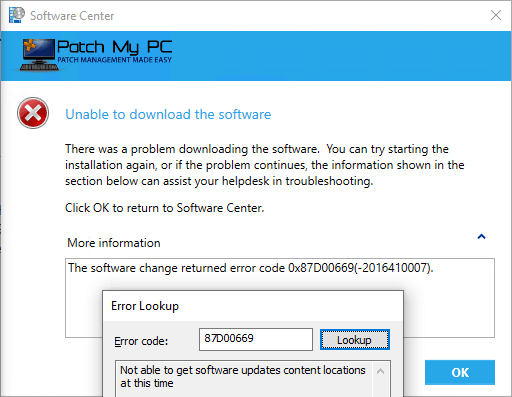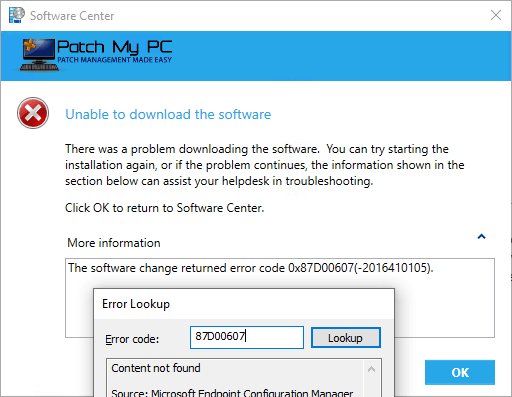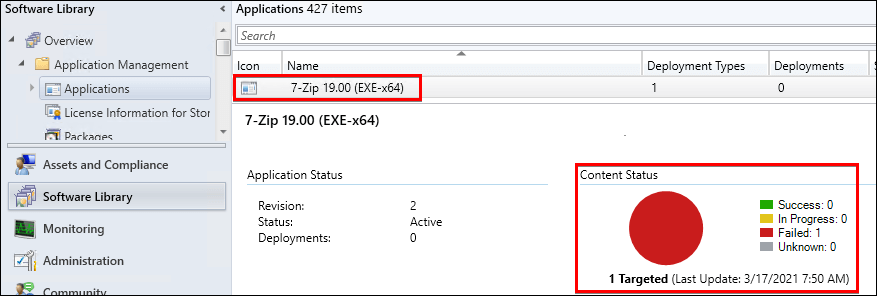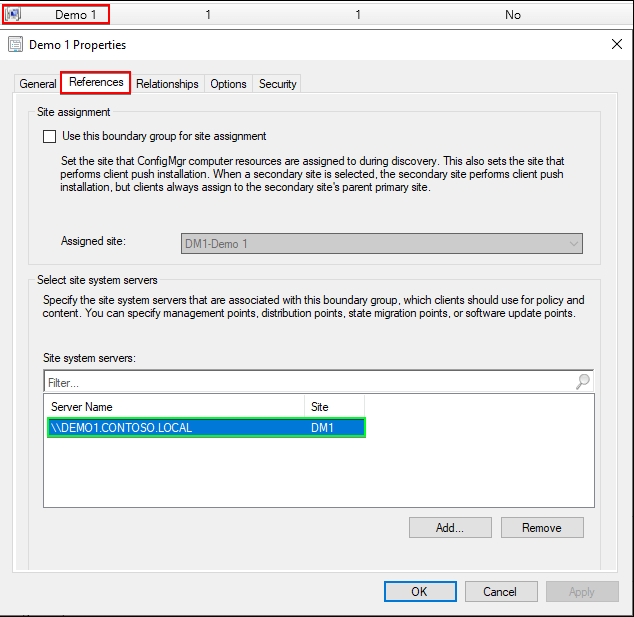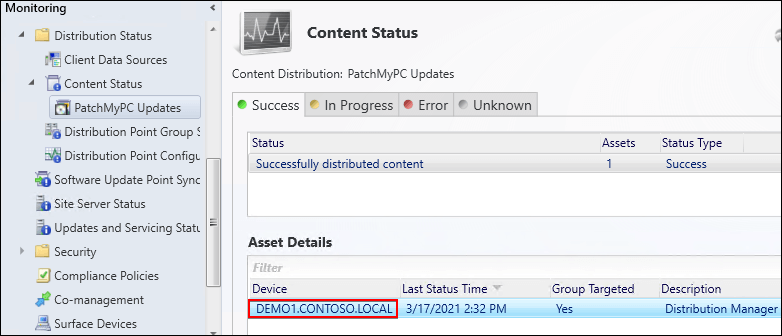Updates or Applications Stuck at Preparing to download or fail with error 0x87D00669 or 0x87D00607
This guide covers common reasons clients fail to download updates with the errors “Preparing to download“, “0x87D00669“, or “0x87D00607” within Configuration Manager.
Topics covered in this article:
- Determine if You are Affected
- Troubleshooting Step 1: Validate the content is successfully distributed
- Troubleshooting Step 2: Check if Client is in Boundary Groups
- Troubleshooting Step 3: Validate Content is Distributed to Correct Distribution Point(s)
- Optional Additional Resources for Advanced Scenarios
Determine if You are Affected
For software updates failing to download, you may see the below error in the UpdatesHandler.log:
CDeploymentJob — Failed to download update (121de25b-8ca6-4e50-8a81-b6baf31d9e5d). Error = 0x87d00669
If your software updates are visible in the software center, you may see the Status column stuck at Preparing to download
If the software update download times out, you will see the following error: The software change returned error code 0x87D00669(-2016410007).
If it’s an application failing to download, you may see the below warning in the CIDownloader.log:
ECCIInfo::SetError – Setting CI level error to (0x87d00607).
If the error is for an application and not a software update, the error will be: The software change returned error code 0x87D00607(-2016410105).
Troubleshooting Step 1: Validate the Content is Successfully Distributed
We see a common issue for clients not to download content because the content is not distributed or the content fails to distribute.
For software updates failing to download, perform the following actions:
Software Library > Software Updates > Deployment Packages > Select the Deployment Package the updates is downloaded to:
Here is an example of a deployment package in a failed state. If a package failed to distribute, clients would be unable to download the content. If the package is in a failed state, you can use the following resource to resolve the issue: Troubleshoot Content Distribution issues – Configuration Manager | Microsoft Docs.
Below is an example of a deployment package that is not distributed to any distribution points. This scenario will also cause clients to be unable to download updates until you distribute the content.
For applications failing to download, perform the following actions:
Software Library > Application Management > Applications > Select the Applications > Summary tab
Validate the application content is successfully distributed and not in a failed or undistributed state.
If the content is successfully distributed and you still have issues, please continue the next troubleshooting step.
Tip: There is no direct way within the Configuration Manager console to view the deployment package(s) a specific software update is a part of. You will need to right-click the deployment package and click view members to review if the update in question is part of the package.
If you have many deployment packages and updates, you can run the following SQL query to see the packages every update is a part of.
Troubleshooting Step 2: Check if Client is in Boundary Groups
The next troubleshooting step if the content is distributed is to validate a machine failing to download the content is within a boundary group. Since ConfigMgr 2002, the easiest way to check if a client falls within a boundary group is to perform the following actions:
Assets and Compliance > Overview > Devices
Right-click on one of the columns and add the Boundary Group(s) column.
The example below shows that DEMO1CLIENT is within a boundary group, but DEMO1 is not within a boundary group.
After validating a client falls within a boundary group, you will want to perform the following steps to validate there is a distribution point site system referenced within that boundary group:
Troubleshooting Step 3: Validate Content is Distributed to Correct Distribution Point(s)
If you are still having issues after the previous 2 steps, you should confirm the content is actually distributed to a specific distribution point in a boundary group from step 2.
Perform the following steps to check the specific distribution points a software update deployment package is successfully distributed to:
Monitoring > Distribution Status > Content Status > Select the deployment package
Right-click on one of the columns and add the Boundary Group(s) column.
Under the Success tab, ensure the content has been successfully distributed to a specific distribution point referenced in the boundary group from the previous step.
Optional Additional Resources for Advanced Scenarios
You can run the following SQL query to determine what deployment packages software updates are available.
— Run this query against your ConfigMgr database to see all software updates and the deployment package they are part of.
SELECT dp.Name AS [Deployment Package] , dp.PkgID , ui.Title AS [Update Title] , c.SourceSize , c.ContentSource FROM vSoftwareUpdatesPackage dp JOIN v_Content c on c.PkgID = dp.PkgID JOIN v_CIToContent cc on c.Content_ID = cc.ContentID JOIN v_UpdateInfo ui on cc.CI_ID = ui.CI_ID AND UI.citype_id in (1,8)
If you want to limit the software updates to only Patch My PC third-party updates, you can run the following query instead.
— Run this query against your ConfigMgr database to see only Patch My PC third-party software updates and the deployment package they are part of.
DECLARE @CatId int SET @CatId = (SELECT cinst.CategoryInstanceID FROM v_CategoryInstances cinst JOIN v_CategoryInfo ci ON ci.CategoryInstanceID = cinst.ParentCategoryInstanceID WHERE ci.CategoryInstanceName = 'Patch My PC') SELECT dp.Name AS [Deployment Package] , dp.PkgID , ui.Title AS [Update Title] , c.SourceSize , c.ContentSource , updcat.CategoryInstanceID FROM vSoftwareUpdatesPackage dp JOIN v_Content c ON c.PkgID = dp.PkgID JOIN v_CIToContent cc ON c.Content_ID = cc.ContentID JOIN v_UpdateInfo ui ON cc.CI_ID = ui.CI_ID AND UI.citype_id = 1 JOIN v_CICategories updcat ON updcat.CI_ID = ui.CI_ID WHERE updcat.CategoryInstanceID = @CatId

